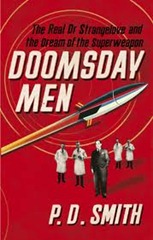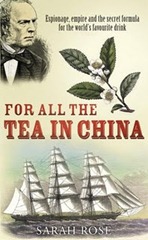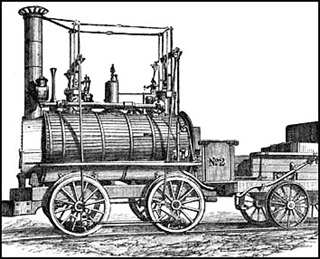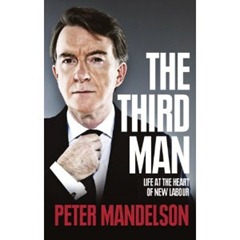 My next book review is on Doomsday Men: The Real Dr Strangelove and the Dream of the Superweapon by P.D. Smith. I arrived at this book via the comments on my earlier post about the Manhattan Project, the Allied project to develop the atomic bombs dropped on Hiroshima and Nagasaki at the end of the Second World War. I also wrote about science fiction, which is relevant to this book too.
My next book review is on Doomsday Men: The Real Dr Strangelove and the Dream of the Superweapon by P.D. Smith. I arrived at this book via the comments on my earlier post about the Manhattan Project, the Allied project to develop the atomic bombs dropped on Hiroshima and Nagasaki at the end of the Second World War. I also wrote about science fiction, which is relevant to this book too.
Doomsday Men brings context to the Manhattan Project, it shows the early imagining of what radioactivity could bring in terms of weapons of war, it shows science fiction writers foreseeing the applications, politicians considering the practical use of weapons of mass destruction and scientists working towards them. Alongside atomic weapons the potential for war from the air had been well considered before it was implemented.
The book starts with the conception of a genuine doomsday superweapon, that’s to say one that would wipe out all life on earth. This had been a theme of science fiction in the past, but in the early 1950’s it became plausible. Essentially the trick is to set off a fusion explosion in the presence of a large quantity of a particular element, cobalt, which would pick up neutrons becoming intensely radioactive whilst being vapourised and cast up into the atmosphere to settle the world over providing a lethal dose of radiation. The amount of cobalt required is about 10,000 tonnes which is only a cube with sides 10 metres long. There’s an open question as to whether the dust would be distributed uniformly enough to wipe out all life.
Leo Szilard is a central character through the book, along with fellow Hungarians John Von Neumann, Eugene Wigner and Edward Teller, known collectively as the Hungarian Quartet. They arrived in the US, fleeing anti-Semitism in Europe and were to play an important part in the development of nuclear weapons. It’s very striking the number of European Jews who migrated to the US in the period after the First World War, including Albert Einstein and Enrico Fermi. In the first instance many of them were keen to help in the development of nuclear weapons as a response to Hitler’s rise in Germany: a state they believed had both the technical ability to make such weapons and, with Hitler, the will to use them in war. Towards the end of the Second World War many of them felt less enthusiastic about their use against the Japanese, despite Japan’s hideous development and use of biological weapons against the Chinese in the 1930’s. Following the war, Von Neumann and particularly Teller continued to be involved in further developments now driven by anti-Communism sentiments.
The route to the doomsday weapon started with the discovery of radioactivity towards the end of the 19th century, and in particular the discovery of radium by Pierre and Marie Curie at the turn of the century. Around 1902 Frederick Soddy and Sir William Crookes both highlighted the huge amounts of energy was bound up in matter. Crookes saying: “one gram could raise the entire fleet of the British Navy several thousand fleet in the sky”. By 1913 H.G. Wells had very explicitly written about a nuclear weapon in “A World Set Free”. The use of chemical weapons, tanks and aeroplanes in war had all been imagined well before they were used too. Clearly there are big technical issues to address in going from a science fiction idea to a real system in battle, but the point here is that these ideas had serious public currency well before they were realised: there could be no “we’ll keep this quiet and no-one will think of it”. In a sense the key theme of the book is the interweaving of fiction with fact through the first half of the 20th century.
It was during the First World War that “scientific” superweapons started to be used, and the importance of science in waging war started to be recognised explicitly. Fritz Haber, a chemist, Nobel prize-winner for his commercial synthesis of ammonia, contemporary of Einstein, was instrumental in bringing chemical weapons to war, he was a German nationalist and felt the development of such weapons a duty to his country. He seemed quite enthusiastic about his work, writing:
“Chlorine: easy to liquefy, disastrous to the human organism, very cheap, mind you! Phosgene: ten times as strong as chlorine. Mustard gas: the best fighting gas of all”.
Once the Germans had used chemical weapons the British and French quickly developed their own. Research and manufacture of chemical weapons was to involve up to 75,000 people by the end of the war – this is about half the number involved in the Manhattan Project. A minority of scientists considered chemical warfare as a blessing compared to the conventional equivalent, for many others it was utterly abhorrent. The military had mixed feelings. Chemical weapons were banned by a variety of treaties, practically they seemed something of a double-edged sword with the first British use of chlorine at Loos causing 2000 casualties on their own side which perhaps explains why they’ve been so rarely used since. With the rise of Nazism Haber, a Jew, was to flee Germany and die shortly thereafter.
The First World War also saw the foundation of the British Board of Invention and Research in 1916, tasked with finding science to fight wars – it sought ideas from the public, one of the which was to train cormorants to peck out the mortar between bricks!
Biological weapons were to be developed by the Japanese whilst at war in China during the 1930’s and the Second World War, in an effort led by Shiro Ishii. During this period thousands were to die through his work, many in a range of human experiments to match those carried out by the Nazi doctors. Following the Second World War Ishii was given immunity from prosecution in order that the US could obtain information on biological weapons from him.
So chemistry and biology produced rather unpleasant weapons but they could not be described as decisive: for that you need physicists.
Szilard was first to realise (in 1933) that an atomic bomb might be made via a chain reaction: the fission of an atomic nucleus producing two or more neutrons which would drive further fission. He made some effort to keep the idea secret, at least from the Germans, via a patent held by the British Admirality. This was a very unusual move for a scientist in an area of pure science. In 1939 he was to visit Roosevelt with Einstein to warn him of the potential for an atomic bomb and the possibility that the Germans would make one. Ultimately this contact led to the Manhattan Project and the bombs dropped on Hiroshima and Nagasaki: killing at least 200,000 people.
One of the recurring themes in fiction was the idea of a scientist discovering the doomsday weapon and then holding the world to ransom for peace with the new “system of the world”: a world government led by scientists and technocrats. This sort of idea is better described as left-wing rather than right-wing. And I can say, as a scientist, that it has a certain appeal! Perhaps this explains something of why scientists are more often perceived as left-wing rather than right-wing.
Doomsday Men ends with the story of Stanley Kubrick’s 1964 film “Dr Strangelove: or How I stopped worrying and learned to love the Bomb”. The title character appears to have been based on a combination of Teller, von Neumann and perhaps Werner von Braun – the German rocket scientist captured by the Americans who went on to found the US space programme.
Overall a rather good read: providing good context to the Manhattan Project and the Cold War, and the importance of science fiction in seeing into the future.
Footnote: one of the drawbacks of reading on a Kindle: I reached the end rather unexpectedly since the footnotes, bibliography, and index take up a third of the book!


 The Immortal Life of Henrietta Lacks
The Immortal Life of Henrietta Lacks
